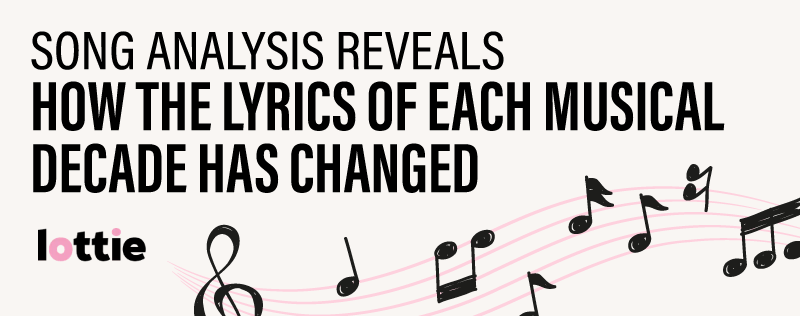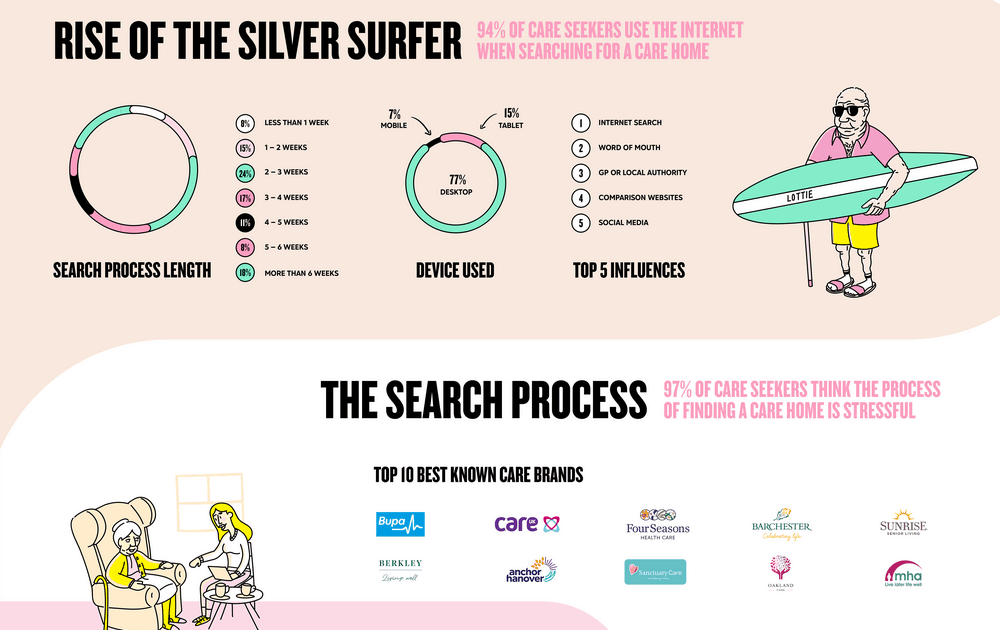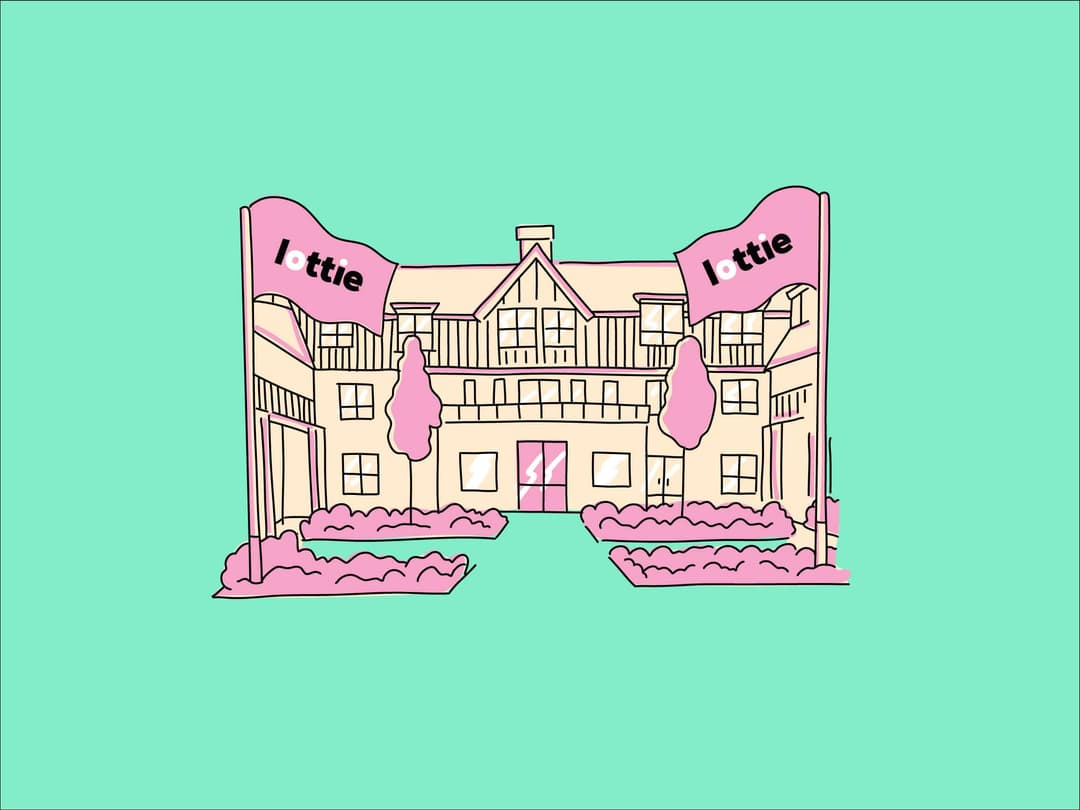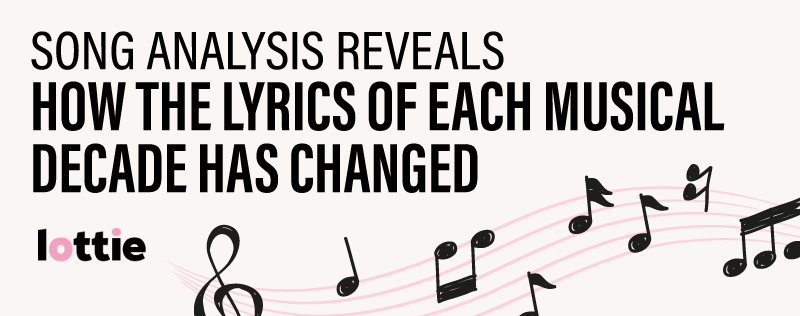Song analysis reveals how the lyrics of music have changed throughout the decades

Estimated Reading Time: 9 minutes
Popular music has changed dramatically throughout the decades, with each era seeing different styles and genres rise in popularity as others fade away. While it goes without saying that the blues-tinged rock ‘n’ roll of Elvis Presley in the 1950s is worlds apart from the contemporary pop stylings of Dua Lipa, there has also been an equally significant shift in the lyrical content of mainstream music within this time.
Pop music has long served as a window into the common attitudes, trends, and issues of the time, so it’s only natural to expect to find notable differences between lyrics throughout the generations.
To find out how lyrics had evolved throughout the generations, Lottie looked at thousands of songs from seven decades, spanning from the 1950s to the 2010s. Looking at words relating to the four key categories of love, swearing, sex, and money, we compared the songs in each decade to determine how lyrical trends have changed over time.
Arrange care at home
Browse the best home care in your area.
Lyrics Related to Love

It should come as no surprise to hear that the subject of love has remained by far the most popular lyrical category throughout the generations. From the romantic innocence of the early Beatles singles to the heartbreak ballads of Adele, love has remained an inescapable subject throughout music history.
Although it remains by far the most popular category, there has been a steady decline in the use of love lyrics since its peak in the 1950s when they appeared in a monumental 88.13% of the songs covered in the study.
While the 1960s may have been responsible for the ‘Summer of Love’, this did not prevent a decline of nearly 4% in romantic lyrics from the previous decade.
The 1970s would bring a crashing halt to the loved-up vibe of the sixties ‘Flower Power’ scene, with more aggressive movements like punk and heavy metal gaining popularity. This change in sentiment can be seen in the stark decline in love lyrics which dropped from 84.53% to 75.93%. Interest in romance would diminish further the following decade, with the ‘80s scoring 71.73% — the lowest percentage of love lyrics in our study.
The 1990s would see a rise in love-related content, with a score of 73.47% reflecting the optimistic vibe of cultural movements like Britpop and Cool Britannia. The first two decades of the new millennium have seen no dramatic shifts, with scores 73.33% and 73.53% indicating that popularity of love songs may be starting to level out.
Explicit Lyrics

The rise of swear words in music over time is indicative of both the changing musical styles and the increased tolerance of taboo language throughout society.
While the 1950s gave us the first incarnation of rock ‘n’ roll rebellion, its swear word percentage of 11.53% looks rather quaint when compared to recent decades. The differences become even more profound when you compare the quantity and diversity of profanities used throughout the years.
Unlike the most recent three decades where the study was able to compile a top 20 list of colourful words used, the ‘50s was found to have only featured four swear words, with two of them being the relatively mild slurs of ‘hell’ and ‘Jesus’.
The 1960s would see a further reduction in swear words, with a score of 9.47%, the lowest of all the decades covered. As expected, the emergence of more aggressive musical movements in the ‘70s would contribute to bad language in song lyrics nearly doubling from the previous decade.
A reduction of over 4% would occur in the ‘80s before a significant rise in the 1990s took the percentage of songs featuring swear words to over 20%. The increase in the nineties could be attributed both to societal changes and the boom of more expletive-heavy musical genres like hip-hop.
The new millennium has seen the rise in swear words continue, with an increase of 2.67% in the 2000s being followed by a further increase of 2.14% the following decade.
We can help you find the best home carer for you or your loved one’s care needs, including domiciliary (hourly) and live-in carers. Request a free list of home care agencies, and our care experts will match you with suitable carers with availability in your local area.
Lyrics Related to Sex

As with swear words, the increased propensity for sex-related songs over time is indicative of a culture that has become increasingly liberal in its attitudes towards sexual discourse.
The 1950s would see the lowest total of sexual words with a score of only 2%. Although the ‘60s are widely regarded as a time of increased sexual liberalism, an increase of just 0.13% suggests that these societal changes had minimal impact on the decade’s lyrical content.
The 1970s would see another small increase in sexual language with a near 1% rise taking the total to 3.07%. The slow trend upwards would continue in the following decade with 3.33% of the songs covered in the 1980s found to contain sexual references. Despite the emergence of sexually explorative artists like David Bowie and Madonna in these two decades, the overall rise in sexual content proved to be minimal.
The 1990s would see steady rise in the use of sexual words from the previous decade, with a total of 5.67%. This increase would be continued in the following decade with 7.07% of songs in the 2000s containing sexual language.
Another increase would occur between the 2000s and 2010s, with the most recent decade’s score of 8.80% suggesting that the trend for sexual content in lyrics is likely to continue.
Lyrics Related to Money

The use of words relating to money in songs has transformed dramatically since the 1950s. That decade’s modest total of 6.53% represents by far the lowest quantity of cash-related lyrics on our list.
The 1960s would see the money references more than double to a total of 15%. The era in which The Beatles sang tales about the taxman and money buying love would set the tone for even more money motivated songs in future generations.
The 1970s would see a 3% increase to 18%, before a considerable drop-off of 3.47% in the next decade. Despite the notorious flaunting of wealth in the videos of many ‘80s pop hits, it appears that the yacht-hopping exploits from the likes of Spandau Ballet and Duran Duran did not translate to increased wealth references in the songs themselves.
With a score of over 21%, the 1990s was the decade with the most songs featuring references to money. Although the 00s would see a decrease of nearly 3%, the percentage of money referencing songs would rise back to 20% in the 2010s.
Conclusion
The rise and fall of certain subjects throughout song lyrics can be based both on evolving musical styles as well as cultural and societal changes.
While some developments such as the increase of sexuality and swearing are a natural reflection of a changing culture, there are some instances where lyrical trends may simply be down to the influence of a particular artist or new musical movement.
Although it’s impossible to predict the direction of song lyrics for future decades, it’s certain that pop music will continue to provide a fascinating window into the culture of the times.
You can use our service to find a care home in your local town or city.
Methodology
Lottie used Natural Language Processing (NLP) to analyse lyrics of songs over the years to analyse how themes change over the years. Lyrics for songs were scraped from lyrics.com, which also provided the release year allowing us to analyse sentiment throughout the decades.
Many of the scraped songs lacked release year labels. In order to obtain additional data, the Musicbrainz database was ingested and matched to the lyrics data, providing us with an additional 4000 song release years. This resulted in a total of 35,000 songs to analyse.
Following this, the lyrics were cleaned using NLP techniques. This involved the removal of stop words from the lyrics. Stop words include words such as “and, then, or”, which do not provide additional information to a sentence. Following this, each word was then lemmatised, which is the process of grouping words with similar forms together. For example, the words study, studying, and studies are all changed to the word study. Finally, duplicates of words in the same song were removed.
A high proportion of songs in the lyrics.com database are from the past few decades, meaning older songs in the 50s, 60s, 70s, and 80s have a lower population. In order to prevent this disadvantage to older songs, each decade (from the 1950s to the 2010s) had a random sample of 2000 songs selected from each. This meant 14,000 songs were used for analysis.
For each decade, If a word appeared less than 50 times in that decade it was removed from the data, so to remove insignificant lyrics and speed up computation. A count of each word in each song was obtained by decade. By using this data, word clouds were generated to show common words by decade
Following this, a Sentiment Intensity Analyser was implemented to analyse each set of lyrics for each song and attach a positive, negative and neutral sentiment score to each. This allowed us to create a positive/negative percentage of songs by decade to show the overall sentiment change over time.
Finally, a seed list of words related to the following topics was complied: Swears, Love, Money, Sex. Words synonymous with each topic were used, for example, “love” included words such as beloved, darling, devotion, baby, and darling were used to identify this theme within a song. Each decade’s songs were parsed for each of these topics to find the percentage of songs that contained these themes. This allowed for the overall themes of music over the years to be compared.
We’re on a mission to support individuals and their loved ones throughout each stage of their later living journey. For more information, check out everything Lottie has to offer.



